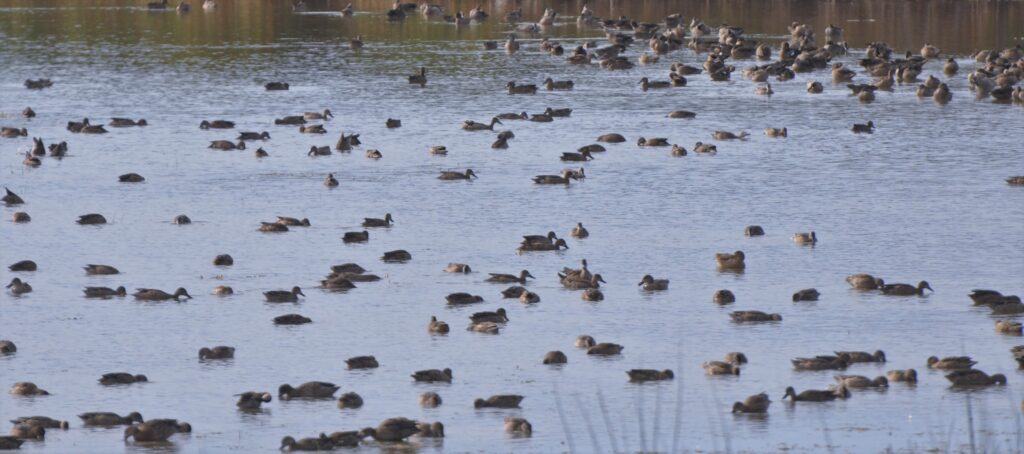Photography courtesy of Lowell Washburn, all rights reserved.
Tempus fugit. I think what those words mean is — Time Flies When You’re Huntin’ Ducks. I’m sitting in a duck blind right now, enjoying some leftover grilled teal as I watch as some live ones swim about. Hard to believe that it is already the last day of this year’s special, sixteen-day Iowa teal hunt.
For most of us, the season has been a roller coaster mix of feast and famine. Most of the famine occurred during the season’s first week or so when North Iowa’s stronghold wetlands held sparse numbers of teal. This was especially disheartening considering that regional water levels and habitat conditions have been ideal. Plenty of water, plenty of food, but few ducks, which for area hunters has resulted in lower-than-normal bags.

Fortunately, the situation began to rapidly improve when, on September 7 and 8, the migration suddenly began to pick up steam. On one of my favorite shallow marshes, blue-wing numbers jumped from a literal count of zero ducks to over 170 teal by September 8th. By September 9, the count had jumped to more than 260. A larger nearby wetland held more than 800 blue-wings.
Considering the escalating change in numbers, it didn’t take a genius to determine that blue-winged teal were on the move. It also became obvious that despite abundant aquatic food sources, the speeding little ducks had no plans to linger. As the migration continued to progress through Iowa, the Louisiana Department of Wildlife & Fisheries reported that around 265,000 blue-wings had already arrived on the state’s coastal wetlands.

As teal continued their exodus from summer wetlands, success for Iowa hunters showed an overall – sometimes dramatic — improvement from September 10 through the season’s September 16th conclusion. As if saving the best for last, the season’s final day provided a dramatic finale to what has been a slower than usual season.
September 16th — Season Finale: The overnight rainfall ended at first light. The breeze was southeast at 7 mph; the temperature a pleasant 54 degrees – reasonable conditions for the season’s final hunt. Walking back to a remote pothole, I was happy to discover a handful of teal sitting on the tiny wetland. Although covered by a mere three or four inches of water, the bed of the pond is carpeted with a thriving crop of sago pondweed. For migrating blue-wings, the little marsh is a food rich oasis of aquatic plant life, snails, and a wide assortment of additional invertebrate taste treats.
Wading into the pond, I began tossing out my teal decoys and was amazed when some of the real thing began landing around me – some birds splashing down as close as six or seven paces. Even more amazing was the fact that the ducks didn’t seem to know what I was. A display of mild caution was the extent of their alarm. It was immediately obvious that these were ‘new birds’ – traveling migrators that had not yet been exposed to hunting pressure. As I continued to wade around placing decoys, the naive birds finally decided they had seen enough and took wing.
Returning to the shoreline I fashioned a makeshift blind from a dense stand of three-square river bulrush. More ducks began buzzing around in the half light. Following what seemed like an endless wait, sunrise shooting time finally arrived. The first bird in was a lone blue-wing which I managed to collect.
There was a brief lull, and then it began. Blue-winged teal began pouring from the sky like I hadn’t witnessed the entire season. As the sun climbed above the eastern horizon, a dramatic full-color, full-arch rainbow suddenly formed against the dark backdrop of a southwestern cloud bank. Many of the blue-wings were approaching from beneath rainbow’s colorful archway. Framed within the bow, the incoming flocks presented a scene of indescribable beauty. In more than six decades of duck hunting, I’ve never seen anything to compare.
The teal kept flying, arriving in groups of all sizes, the largest containing up to 18 or 20 birds. Business was brisk and within minutes, I had downed my six-duck limit. The breeze was picking up, the skies had become partly cloudy, the sun was shining down, and it had begun to rain again. A typical display of bizarre Iowa weather.
Finishing off my leftover teal breast, I decided to pick up and head for the truck. Ducks were still flying and a few even landed as I gathered the decoys. Teal had been landing in the spread when I set up, and the blue-wings were still splashing in as I picked up. This had indeed been a day to remember. Time flies when you’re huntin’ ducks.

 Tom Cope
Tom Cope Sue Wilkinson
Sue Wilkinson Susan Judkins Josten
Susan Judkins Josten Rudi Roeslein
Rudi Roeslein Elyssa McFarland
Elyssa McFarland Mark Langgin
Mark Langgin Adam Janke
Adam Janke Joe Henry
Joe Henry Kristin Ashenbrenner
Kristin Ashenbrenner Joe Wilkinson
Joe Wilkinson Dr. Tammy Mildenstein
Dr. Tammy Mildenstein Sean McMahon
Sean McMahon